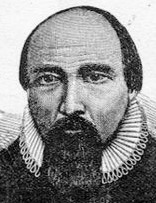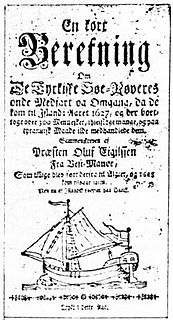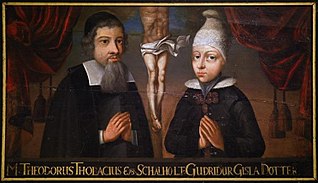 W
WArngrímur Jónsson the Learned was an Icelandic scholar and a Christian apologist. His father was Jón Jónsson, who died in 1591. Arngrímur studied in Copenhagen, completing his studies in 1589 and taking up a position back in Iceland as rector of the Latin school at the episcopal seat of Hólar in the same year.
 W
WBrynjólfur Sveinsson served as the Lutheran Bishop of the see of Skálholt in Iceland. His main influence has been on modern knowledge of Old Norse literature. Brynjólfur is also known for his support of the career of the Icelandic poet and hymn writer Hallgrímur Pétursson. Brynjólfur Sveinsson is currently pictured on the 1,000 Icelandic króna banknote.
 W
WGísli Þorláksson was an Icelandic bishop. He was a son of Þorlákur Skúlason and brother of Þórður Þorláksson.
 W
WGuðbrandur Þorláksson or Gudbrand Thorlakssøn was bishop of Hólar from 8 April 1571 until his death. He was the longest-serving bishop in Iceland and is known for printing the Guðbrandsbiblía, first complete Icelandic translation of the Bible.
 W
WGuðríður Símonardóttir was an Icelandic woman who was one of 242 people abducted from the Westman Islands, Iceland in 1627 in a raid by Barbary pirates. These raids came to be known as the Turkish abductions. After being held as a slave and concubine for nearly a decade, she was one of a few captives ransomed by the Danish king. She returned to Iceland, marrying the young theology student Hallgrímur Pétursson, who became known for his poetry and hymns.
 W
WHallgrímur Pétursson was an Icelandic poet and a minister at Hvalsneskirkja and Saurbær in Hvalfjörður. Being one of the most prominent Icelandic poets, the Hallgrímskirkja in Reykjavík and the Hallgrímskirkja in Saurbær are named in his honor. He was one of the most influential pastors during the Age of Orthodoxy (1580–1713). Because of his contributions to Lutheran hymnody, he is sometimes called the Icelandic Paul Gerhardt.
 W
WÁrni Magnússon was an Iceland scholar and collector of manuscripts. He assembled the Arnamagnæan Manuscript Collection.
 W
WÓlafur Egilsson was an Icelandic Lutheran minister. In 1627, he was abducted, along with his wife and two sons, by Barbary Pirates under the Ottoman Empire during their raid on Vestmannaeyjar. The raid is known in Icelandic history as Tyrkjaránið. He returned to Vestmannaeyjar in 1628 but his wife Ásta Þorsteinsdóttir did not return until 1637 and his sons never returned. He later wrote a memoir of his abduction and return, which was published both in Iceland and in Denmark.
 W
WRagnheiður Jónsdóttir (1646–1715) was a wealthy member of the powerful Svalbarðsætt family. She was married twice, each time to a Lutheran bishop of Hólar: Gísli Þorláksson and Einar Þorsteinsson. She survived both husbands and retired in 1685 to the farm of Gröf in Höfðaströnd, just south of the modern-day village of Hofsós, appointing her younger brother Oddur as ráðsmaður.
 W
WÞórður Þorláksson, also known by the Latinized name Theodorus Thorlacius, was the Lutheran bishop of Skálholt from 1674 until his death. Under Þórður's direction, the Church of Iceland's printing press was moved from Hólar í Hjaltadal to Skálholt where he established the first print archive in the country.
 W
WThormodus Torfæus (1636—1719) was an Icelandic historian, born 27 May 1636 at Engey, Iceland and educated at the University of Copenhagen. He lived and worked for most of his life in Kopervik, Karmøy, Norway. In 1667 he was appointed royal antiquary of Iceland, and in 1682 King Christian V of Denmark appointed him Royal Historian of the Kingdom of Denmark-Norway. He translated several Icelandic works into the Danish language and was the author of Historia Vinlandiæ Antiquæ (1705); Grœnlandia Antiqua (1706); and Historia Rerum Norvegicarum.